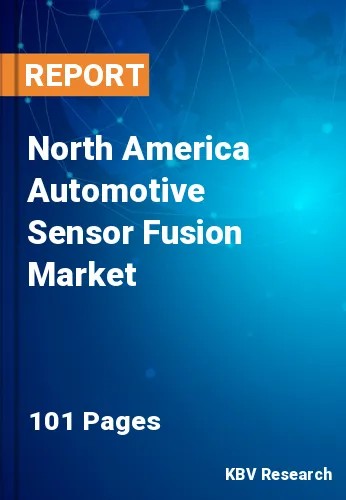The North America Automotive Sensor Fusion Market would witness market growth of 22.3% CAGR during the forecast period (2022-2028).
In the past, cameras or radars were packed with the computational power needed to evaluate sensor data to identify and track things. Low-level sensor data can be gathered from each sensor and combined in the more potent active safety domain controller due to the centralization of processing power. Increased data exchange is an additional advantage.
Traditional systems use smart sensors that separately process environmental inputs, thus any judgements based on the information are only as good as what each sensor can observe. Active safety applications in the domain controller have additional opportunities to use sensor data when it is shared centrally under the Satellite Architecture, though. Autonomous vehicles (AVs) make decisions for safe navigation using advanced sensory systems to assess the outside environment.
Autonomous vehicles employ sensor fusion to interpret their environment in a similar way to how individuals use their senses of sight, taste, sound, smell, and touch. Autonomous driving systems can profit from the strengths of each individual sensor while balancing out the aggregate advantages of using a variety of them. Sensor fusion data is processed by autonomous cars using preprogrammed algorithms. This enables autonomous cars to make decisions and choose the appropriate course of action.
The full ratification of Mexico's National Law of Mobility and Road Safety in May 2022 represents a significant advancement in the nation's efforts to lower the stubbornly high number of traffic fatalities and to increase fair and sustainable access to transportation services for everyone. The rate of traffic fatalities in Mexico, a nation of around 130 million people, has remained continuously high in recent years despite substantial action at the national and sub-national levels. In only 2019 alone, more than 16 000 deaths were reported. The rising cases of road collisions have raised the need for better technologies for security, thereby offering growth opportunities to the regional automotive sensor fusion market.
The US market dominated the North America Automotive Sensor Fusion Market by Country in 2021, and would continue to be a dominant market till 2028; thereby, achieving a market value of $1,521.7 Million by 2028. The Canada market is poised to grow at a CAGR of 25.1% during (2022 - 2028). Additionally, The Mexico market would witness a CAGR of 24% during (2022 - 2028).
Based on Propulsion Type, the market is segmented into ICE, BEV, and HEV. Based on Vehicle Type, the market is segmented into Passenger Cars, Light Commercial Vehicles, and Heavy Commercial Vehicles. Based on Technology, the market is segmented into IMU, Image Sensors, Radar Sensors, and Others. Based on countries, the market is segmented into U.S., Mexico, Canada, and Rest of North America.
Free Valuable Insights: The Global Automotive Sensor Fusion Market is Estimated to reach $7.3 Billion by 2028, at a CAGR of 22.8%
The market research report covers the analysis of key stake holders of the market. Key companies profiled in the report include NVIDIA Corporation, NXP Semiconductors N.V., Robert Bosch GmbH, TE Connectivity Ltd., Infineon Technologies AG, ZF Friedrichshafen AG, TDK Corporation, STMicroelectronics N.V., Aptiv PLC, and Texas Instruments, Inc.
By Propulsion Type
By Vehicle Type
By Technology
By Country
Our team of dedicated experts can provide you with attractive expansion opportunities for your business.

